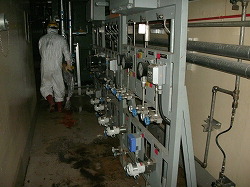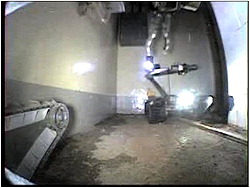|
TOKYO (Kyodo) — Radiation dosages of 5 sieverts per hour were detected indoors on the second floor of the No. 1 reactor at the crisis-hit Fukushima Daiichi nuclear power plant on Tuesday, the highest figure yet indoors, plant operator Tokyo Electric Power Co. said.
The figure was detected in front of a pipe in an air-conditioning machine room, the utility said, adding the dosage may be larger than the measured amount as it exceeds the capacity of measuring equipment.
Radioactive substances are considered to be staying in the pipe after they entered there when pressure in the reactor's containment vessel was lowered on March 12, according to Tokyo Electric known as TEPCO.
The company has made the area off-limits.
TEPCO also said radiation doses of more than 10 sieverts, or 10,000 millisieverts, per hour were detected outdoors again Tuesday at the plant.
If exposed to such a high-level dosage of radiation in a short period of time, almost all people exposed would die, radiation experts said.
|
On Monday, Tokyo Electric said radiation doses of as high as 10 sieverts per hour were detected outside the buildings for the No. 1 and No. 2 reactors.
Gamma camera images which show radiation doses by color indicated red at the bottom of the main exhaust pipe between the two reactor buildings, which means radiation doses top 10 sieverts per hour, TEPCO said.
On Tuesday, more than 10 sieverts per hour were detected at an area near the scene, with those images also showing red at a height of 10 meters above ground on the back of the exhaust pipe.
TEPCO said radioactive substances might have adhered to the back of the exhaust pipe after they were emitted when the company vented at the No. 1 unit to lower pressures within the reactor pressure vessel and reactor container.
TEPCO said those places with high doses of radiation pose no major trouble for the company's work to contain the nuclear crisis and that it has no plan to measure radiation doses in detail.
On Monday, TEPCO said its plant workers confirmed the high-level doses of radioactivity Monday afternoon when they put the measuring device to the surface of the exhaust pipe. The level may have been higher than the measured amount of 10 sieverts per hour as it exceeds the capacity of measuring equipment.
|
Previously, the highest dose detected indoors was 4 sieverts per hour measured at the floor of the No. 1 reactor building.
Meanwhile, State Minister Goshi Hosono, who is in charge of the nuclear accident, called Tuesday for correctly analyzing the situation, saying at a news conference that a correct grasp is essential to settle long-term issues involving the Fukushima Daiichi plant that was crippled by the March 11 earthquake and tsunami.
Copyright © 2011 THE MAINICHI NEWSPAPERS. All rights reserved.
Reprinted for Fair Use Only.


